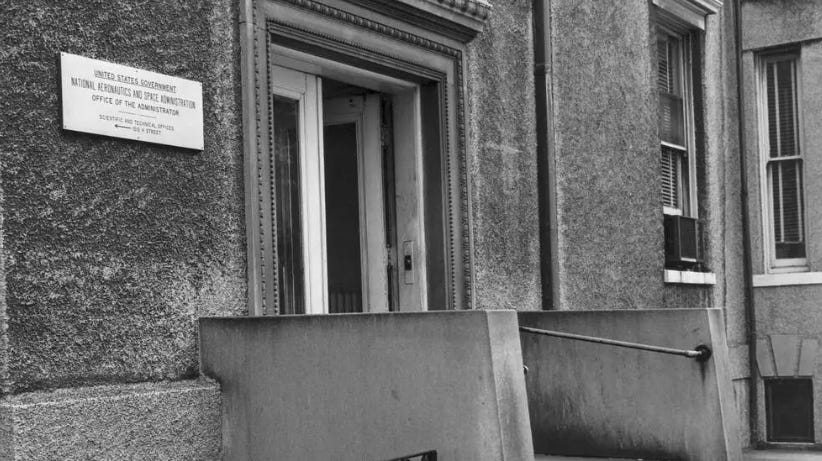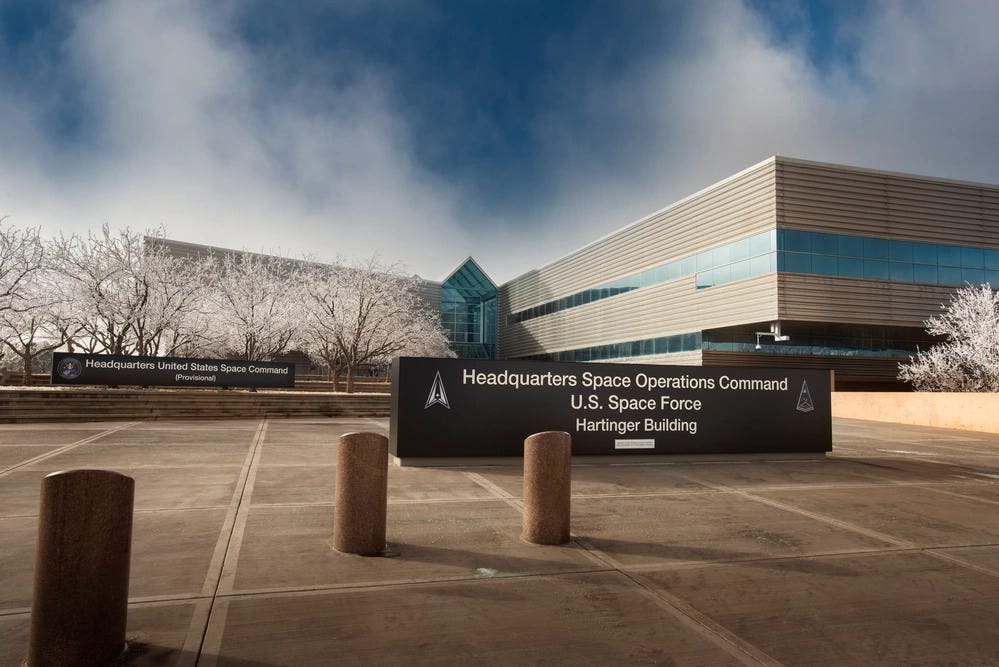In My Back Yard
Florida Politicians are Trying to Mandate that NASA Headquarters Move to Kennedy Space Center
The first NASA Headquarters was the Dolley Madison House on Lafayette Square in Washington, DC. Image source: NASA.
NIMBYs are people who got their piece of the pie, but don’t want others to get their share. It stands for Not In My Back Yard, and often refers to those whose residential development infringed on a natural land or someone else’s tranquility, but now protest that the same is about to happen to them.
I haven’t heard of an IMBY (In My Back Yard), but perhaps we’re about to experience that here on the Space Coast.
On January 9, eleven days before Donald Trump reclaimed the White House, Florida Governor Ron DeSantis said he wants NASA to move its headquarters from Washington, DC to Kennedy Space Center.
This could be dismissed as pandering to the locals, because it makes no sense at all. That’s like saying the Pentagon should move to Fort Liberty in North Carolina or Laughlin Air Force Base in Texas.
Brevard County’s novice House representative, Mike Haridopolos, has joined the campaign. He told Florida Today, “As a Floridian — and as the president is a Floridian — I'd love to have the NASA headquarters here at KSC.”
The pandering is inspired by a November 14, 2024 press release announcing that the agency’s lease on its current facility expires in August 2028. NASA is evaluating options, “including leasing or purchasing within the District of Columbia.” The current building is leased, and NASA uses only a few floors of it. “The desired location is within walking distance to a Washington Metropolitan Area Transit Authority station.” That certainly doesn’t describe KSC.
But the new president is in a bullying mood, so the hope is they can convince him to disregard common sense and force NASA to uproot to the Sunshine State.
NASA HQ is in DC for a reason — its executives interact daily with members of Congress and their staffers. They also interact with other agencies in the DC area, such as Defense, NOAA, FAA, and even the Fish and Wildlife Service. (KSC shares borders with the Merritt Island National Wildlife Refuge.)
From its inception on October 1, 1958, NASA’s headquarters has always been in DC.
According to NASA’s website, the first headquarters was the old Dolley Madison House on Lafayette Square within a block of the White House. The agency moved on to other federally-owned buildings, most famously in 1963 to 600 Independence Avenue Southwest. The National Air and Space Museum opened across the street in 1976.
Today’s leased NASA Headquarters at 300 E St. SW. Image source: NASA.
In 1992, the agency chose to move to a rented building, at 300 E Street SW. The building has been sold several times, most recently in 2018 to a South Korean investment firm. The company put the building up for sale in January 2022, but in August 2022 found another investor to help pay off its debt. NASA renewed its lease in 2011, but apparently intends to move on in 2028.
One reason for the move is that NASA simply doesn’t need all the space, pun intended.
A January 1999 Government Executive article reported that, due to significant downsizing, NASA HQ was operating “with less than half the staff it had in 1992.”
Because of the NewSpace movement, much of American launch services are now contracted out to the private sector. By the end of the decade, the International Space Station is scheduled for retirement, to be succeeded by commercial habitats. NASA is returning to its 1958 roots as an aerospace research and development agency.
Rumors abound that the Trump administration will cancel Space Launch System in favor of a commercial option, such as the SpaceX Starship or Blue Origin New Glenn. If that happens — still a big “if” — then NASA will end contracts managing SLS, meaning hundreds if not thousands of contract employee layoffs, many of them in the Space Coast.
It also means that Congress will have to decide what to do with the excess NASA civil servants. In 2010, when Constellation ended, Congress forbade “any reduction-in-force or other involuntary separations” of NASA civil servants before September 30. 2013. (2010 NASA Authorization Act, Sec. 1105.) To comply with the law, NASA had to find make-work activities for those civil servants, needed or not.
Another way this proposal can run afoul of Congress is by elevating one NASA center above the others. Each of the ten centers is guarded by zealous members of the legislative branch.
When NASA was formed in 1958, Congress and the Eisenhower administration basically decided to graft various non-military federal space activities onto the existing National Advisory Committee for Aeronautics. The NACA had been around since 1915, doing mostly aviation R&D, but it had also branched into some space research, such as blunt bodies travelling at supersonic speeds. The X-15 spaceplane began with the NACA.
In October 1958, the NACA already had research facilities across the nation. Among those were the Langley Research Center in Hampton, Virginia; the Lewis Flight Propulsion Laboratory in Cleveland, Ohio; and the Ames Research Center at Moffett Field, California. The NACA also had research operations at Edwards Air Force Base in the Mojave Desert of California. The new NASA absorbed those facilities, as well as the Army’s contract with the Jet Propulsion Laboratory in Pasadena, California. The Army Ballistic Missile Agency in Huntsville, Alabama (where Wernher von Braun was based) was transferred to NASA in 1960 to become the Marshall Space Flight Center.
As NASA grew during its first ten years of existence, it added many new centers, such as KSC near Cape Canaveral; Johnson Space Center in Houston, Texas; the Goddard Space Flight Center in Greenbelt, Maryland; the Stennis Space Center in Mississippi; and the White Sands Test Facility in New Mexico.
To argue that NASA’s raison d'être is crewed spaceflight is a fundamental ignorance of what the agency does. Each of these centers has a unique purpose. Langley, for example, still does research to keep the American aviation industry ahead of international competitors. There’s no reason for one center to be elevated over the others. Congressional representatives of Marshall, Johnson, and others would loudly protest.
Sure, some efficiencies could be found through consolidation, but historically members of Congress have fought any proposed closures.
US Space Command provisional headquarters in Colorado Springs, Colorado. Image source: Christopher DeWitt, United States Space Command.
Trump has tried for years to forcibly transfer US Space Command from Colorado to Alabama. In January 2021, Trump ordered Space Command transferred from Colorado Springs, Colorado to Huntsville, Alabama to reward the Alabama Republican congressional delegation for protecting him during his second impeachment for attempting to violently overthrow the 2020 election results. He admitted as much in an August 2021 radio show interview.
An internal review by the Defense Department’s Office of the Inspector General (OIG) released in May 2022 concluded that the process “complied with law and policy, and was reasonable in identifying Huntsville as the preferred permanent location.” But a Government Accountability Office (GAO) external review released in June 2022 concluded that the Air Force failed to follow most of its guidelines in transferring Space Command to Huntsville.
President Joe Biden in July 2023 decided to leave Space Command in Colorado. Now that Trump has returned to office, the Alabama delegation believes that the president will move Space Command to Huntsville.
The Space Command battle between the Colorado and Alabama congressional delegations is a preview of what might happen should Trump decide to force NASA to leave DC for Florida. That could lead to a war between congressional delegations from Florida, Alabama, Texas, and other Trump-friendly states seeking favor. Politicians without a NASA center might want to keep NASA HQ in DC, or fight in favor of a major aerospace contractor in their state.
Trump’s NASA administrator nominee, Jared Isaacman, has yet to have a Senate confirmation hearing. I wouldn’t be surprised if relocating NASA HQ comes up as a question. Ted Cruz (R-TX) chairs the Senate authorization committee with NASA oversight that would hold the hearing, so expect him to lobby for a move to Houston. No one from Florida sits on the committee.
With any luck, this bad idea is tossed into the dustbin of history for future historians to mock.



